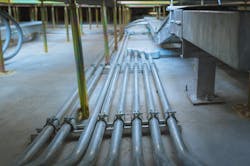Views from the Ground: Electrical Contractors Building Data Centers Weigh In
The rise of data centers in the national capital area has meant unprecedented growth for the International Brotherhood of Electrical Workers Local 26 and the Washington DC Chapter of the National Electrical Contractors Association. Through our strong partnership, we build the largest and most complex data center campuses in the world.
We’ve discussed at length the importance of union labor and our impact in bringing data centers to market on time and on budget. We sat down with two leaders building data centers in the national capitol area who had insight to share on industry changes and the benefits of being a union electrician.
First up is Andrew Mason, a General Foreman at Power Solutions, currently working on a data center project in Loudoun County, Virginia. Andrew has been a member of IBEW Local 26 for over 25 years. He mans one of the largest crews around with over 250 electricians and has been building data centers for the last 10 years.
How do data center jobsites compare to other construction jobsites?
“The jobsites are faster paced, better managed, and rarely if ever exceed any of the timeframes for construction. On any given site you can see a large portion of the electrical industry from medium voltage systems, fire alarms, to controls, everything is covered.”
How much has your company grown over the last 9 years?
“It has more than doubled from 600 to over 1600 electricians.”
How many apprentices do you have in your crew?
“60-70 at any given time. Ranging from 1st-5th years, a lot of them from Loudoun or neighboring counties.”
Anything else you’d like to say about data center construction?
“Construction times are short, maybe a year, and they aren’t noisy like people say. Data centers bring better infrastructure upgrades like fiber to communities. The data centers look a lot better now with the advances in design, landscaping, and viewsheds in mind.”
Next, we spoke with Will Warwick, COO of Hanley Construction and native of Falls Church, VA.
How long have you been signatory for Local 26? How has your business grown in that time?
“We have been signatory with Local 26 for 3 years and grown from a shop of 3 guys to over 200 spread across three different regions in the United States.”
What percentage of your work is in data centers, and what types of services do you perform?
“About 90% of our work is in data centers. We do medium voltage specialty work, controls, system integration, testing, commissioning, and more. Most of my guys have taken specialty classes and continuing education through the JATC*.”
How much money do your electricians make?
“Our electricians make good six figure salaries with full benefits. They don’t need to worry about needing dual income families. When a water heater breaks at home, it doesn’t financially ruin them.”
Anything else you’d like to say about the data center industry?
“The age of the technician is now. It’s not lawyers or doctors. Everything is about data, programming, AI, and wiring. This industry gives people an opportunity to an incredible future. This is generational work and a generational way of life.”
As the demand for data centers continues to grow, the demand for quality technicians grows. Union electricians benefit from safe working environments, above average compensation, and continuing education that empower them to build incredible futures for themselves and their families, doing critical work that benefits our communities.
*The JATC is the Joint Apprenticeship and Training Committee, the registered electrical apprenticeship run in partnership between IBEW Local 26 and WDC NECA.
About the Author

David Pala
David Pala handles marketing and communications and his portfolio includes grant management, business development and political organizing for IBEW Local 26.



